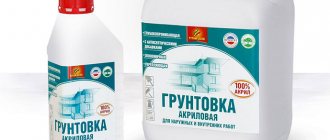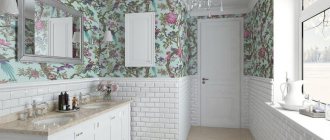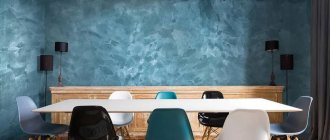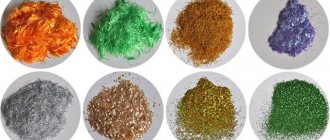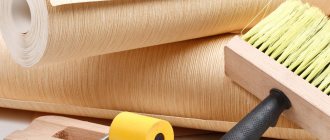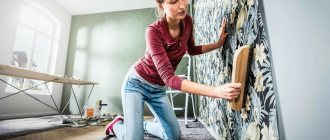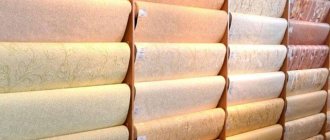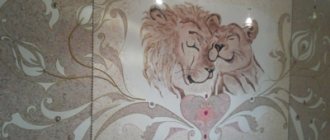Savig
8523 0 6
Savig October 26, 2017Specialization: master of interior finishing works. I am well versed in power tools for repair and construction. Formerly a teacher at a radio engineering college.
With the right approach, when combining panels with wallpaper, you can get an excellent result
Is it possible to glue wallpaper on PVC or MDF panels? In search of answers to this question, I propose to consider the features and instructions for combining these finishing materials. Visual illustrations will help you understand everything.
Is it possible to glue wallpaper on MDF panels?
Share on social media networks:
Sometimes, due to the characteristics of the premises, during interior decoration we are forced to resort to the use of several types of finishing materials at once. This method allows you to focus on the obvious advantages of the interior, hiding some of the disadvantages of the room itself or each of the finishing materials. Today, one of the most popular options is a combination of wallpaper and various panels - PVC, MDF, SIP and others. While some people are just wondering whether it is possible to glue wallpaper on MDF panels, this method of decorating the interior has already proven itself to be effective in both living rooms and non-residential premises. Let's look at this technology in detail.
Features of applying liquid wallpaper
Working with this material differs from the previous process in the technology of the last stage. This variety must be laid with a spatula and a trowel according to a pattern identical to puttying. To do this, the pre-prepared mixture is distributed into sections in an even layer.
The technique of gluing liquid wallpaper is similar to applying putty
There is an opinion that when using liquid wallpaper, putty is not needed, but the technology should not be violated.
How to glue wallpaper on panels?
Construction hypermarkets and finishing materials markets sell a wide range of different types of decorative panels for finishing walls and ceilings. We will look at the most popular of them, and also answer the question of whether it is possible to glue wallpaper on MDF and similar materials, and how to do it correctly.
PVC wallpaper and trim
Before you start gluing wallpaper in combination with plastic panels, you need to prepare the work surface. Your flow of action should look something like this:
- Prepare all the necessary tools and materials - primer for plastic panels, solvent, sandpaper or its equivalent with fine grain.
- Sand the glossy surface, making it matte where the panel and wallpaper are attached (for better fixation).
- Wipe off any fine dust from the surface of the plastic with a slightly damp cloth and wait until it dries completely.
- Apply a primer that is designed specifically for use on plastic trim.
- Treat the surface using special tools with an adhesive primer with the addition of a solvent.
Surface preparation is complete. Now you can start gluing wallpaper, no longer wondering whether it is possible to glue wallpaper on plastic panels, because the answer will be positive: yes, it is possible!
Panels made from wood products
In many large construction stores you can easily purchase analogues of decorative panels made from woodworking products. They contain ground coniferous wood. Small particles are bonded together by pressing at high temperatures. Thus, MDF panels do not contain “chemicals” such as resin, glue, etc.
Important! Such panels have good heat and sound insulation properties. As a rule, the width of the MDF panel is 58-60 cm, height - 2.5-2.7 m, thickness - 12 mm. Today on sale you can find a wide selection of MDF panels of various colors and textures.
Modern production technology creates light and porous boards with good density, which makes it possible to glue wallpaper or even textiles onto similar MDF panels. In this case, any type of wallpaper can be used - paper, vinyl, fiberglass and others. That is, to the question whether it is possible to glue wallpaper on MDF, the answer will be positive, but under a mandatory condition: the panels must be well primed with a special compound so that they do not absorb all the glue.
Liquid wallpaper and SIP panels
A popular type of finishing today is a combination of SIP panels and liquid wallpaper.
Installation of the latter on decorative surfaces, including SIP panels, is quite simple. However, when using liquid wallpaper in a room with high humidity, it should be additionally treated with a protective layer of a special coating.
In general, liquid wallpaper is a good option for interior decoration. They have excellent performance characteristics, and at the same time have a beautiful appearance thanks to the various inclusions included in the composition. Plus - they are quite easy to install, which even a non-professional can handle, following the instructions.
Specifics of chipboard cladding
Wallpapering on chipboard is similar to gluing on a concrete wall or plasterboard. The difference is that the chipboard surface has its own characteristics and undergoes special preparation.
Characteristic features of a slab wall:
- Roughness of the plane.
- Openings between slabs.
- Open screw heads.
It will not be possible to completely seal a wall without joints, since the largest common size is 3.5 m by 1.75 m, and if you make it solid to order, there is a high probability of it breaking and inconvenient fastening.
Sealing the joints is a must before wallpapering. It is this part of the slab that can cause big trouble if it is not treated and closed. When the openings are open, swelling of the material will occur, as a result of which the canvas will tear. Large joints are foamed, but then make a strip up to 2 cm deep for caulking. Tape regular seams with a gauze strip or sickle tape. Coat with a special ready-made mixture or dilute the dry mixture according to the instructions.
If the slabs have significant unevenness, then they are completely puttied: first the joint is filled, then serpyanka is applied, a layer of putty is applied on top and cleaned after drying.
If you do not seal the heads of nails or screws, then over time they will begin to rust, showing marks through the wallpaper. To avoid this, it is necessary to hammer or screw the caps to a depth of 2 mm, and coat the recesses with drying oil or paint.
How to combine materials correctly?
There are a huge number of options for combining different finishing materials. Let's look at the features of using the most popular of them when decorating small apartments or country houses.
Geometric combination of finishes
The design of surfaces with alternating vertical or horizontal inserts of wallpaper and panels is suitable for absolutely any room design:
- Fragments can be highlighted by alternating different panels and wallpapers for decoration. The most suitable for this option would be thick vinyl or non-woven wallpaper with relief.
- Stripes can be alternated in different colors - contrasting or solid shades.
- The width of the strips that is optimal for the room should be selected based on the height of the ceiling or the length of the wall.
- The decoration of the corridor and other rooms can clearly demarcate each other with borders, friezes, and moldings. Such material will not only disguise the joints, but also serve as a decorative element.
Application of inserts:
- The first step is to prepare the walls, prime them with a special solution.
- The surface is then wallpapered or paneled.
- Next, the necessary finishing is installed in pre-designated areas.
Important! Inserts can be strips of wallpaper or sections of panels of different shapes and sizes. This method involves decorating some elements with borders or moldings.
Wallpaper inserts over a large area
This method is necessary for finishing different semantic areas in one room, that is, for its zoning. For example:
- When dividing a children's room into a bedroom, play area and study area, you can install panels of calm colors in the area of the bed and desk, and apply brightly colored canvases for the play area.
- For a living room, a good option is to use contrasting panels or wallpaper to highlight a niche with a TV installed.
- In the bedroom, the most commonly used option is to highlight the head of the bed. The best option is a combination of wallpaper and panels that have different shades of the same color.
Application of flaps
This original method of combining finishes is suitable for creating an unusual room design. Here everything is limited only by the imagination of the master. Wallpaper is cut into pieces of various shapes and sizes. Then they are glued to the surface in any order, creating beautiful patterns.
Important! Do not forget about pre-treatment of the panels before applying wallpaper to them.
Non-standard room geometry - what to do?
If the room has a complex configuration with the presence of ledges and niches, do not be upset and consider this fact a disadvantage of the house. It is easy to make such a design an advantage, and you don’t have to spend a lot on such changes. To do this, you simply need to highlight all non-standard areas from the general space of the house by combining different finishing materials. Having played with the complex shape of the room in this way, your eyes will see a completely different view of it.
How to prepare chipboard walls for wallpapering
- First of all, you need to clean all the chipboard walls, removing all dirt from them, be it old wallpaper or something else.
- Next, you will need to cover the chipboard joints with gauze.
- Afterwards we move on to priming the chipboard and you need to let the primer dry.
- Next, we putty the walls and let the putty dry.
- We clean the walls with sandpaper.
- We prime the walls with a finishing primer.
This way we properly prepare the walls for wallpapering. It is worth understanding that such operations to prepare chipboard for wallpapering are simply necessary, otherwise your walls will look bad, even if you stick good, expensive wallpaper on them.
Is it possible to glue wallpaper onto wood boards?
There are two opposing opinions on this issue. Some of the craftsmen talk about the complete impossibility of carrying out such internal work, while the other says the opposite.
The fact is that non-woven, vinyl and paper products are usually glued without serious surface preparation. Often this is a simple matter of removing old coating. But this happens in the case of walls finished with plaster, which ensures the necessary adhesion of materials. If the work is carried out on a base of wood boards (chip and fiber), then problems arise. First of all, this is the subsequent peeling of strips in corners and at joints. Such defects arise due to poor surface preparation; it requires much more time and effort.
Indeed, gluing wallpaper on fiberboard, chipboard and MDF is not easy, but if everything is done step by step and correctly, the integrity of the coating will be ensured.
Conclusions on the topic
Nowadays, queries in search engines are quite popular regarding whether it is possible to glue wallpaper to unprepared surfaces. Of course, any professional will tell you that it is impossible. However, we will say that it is possible, but the result most likely will not suit you. In the event that you decide to glue it to unprepared concrete walls, then it may turn out quite well, but in the case of chipboard, or other materials such as OSB, drywall, etc., all the seams will be visible through the wallpaper and soon the wallpaper may tear.
Combination of finishing materials
Why combine at all, if, for example, you can simply install panels instead of wallpaper on the wall and not spend additional money on the canvases themselves? Or, on the contrary, don’t bother with installing plastic or wooden sections, but traditionally use paper cladding, which will be even cheaper? This is because both types of these finishing materials complement each other favorably, which more than compensates for the extra expenses:
- Wallpaper decorates the panels . The incredible number of colors and patterns offered by paper or vinyl sheets provides the designer with a much wider range of options compared to plain sections made of PVC or medium-density fiberboard;
Photo of a display window in a wallpaper store, clearly demonstrating the range of products offered
- The panels create an ideal base for wallpaper and open up new zoning possibilities . Paper sheets fit perfectly on a smooth and hard surface, not like cracked plaster or bumpy concrete. In addition, it becomes possible to combine a section not only on the wall, but in any part of the room.
A false wall made of panels and wallpaper will help divide the living room into two different functional areas
In addition to the fact that wallpaper can be glued to wall panels, it can also be glued above them. This gives two positive aspects: firstly, the room is visually stretched upward, and secondly, the lower and more vulnerable part of the wall receives better protection.
When combining two different materials, you should run the wallpaper under the panels, then the place where they meet will not be externally noticeable
So, as you can see, if the slightly higher price of this method of interior design does not stop you, you can safely use it: the result will be both beautiful and practical.
Wallpaper and PVC panels
Is it possible to glue paper sheets to PVC wall sections? The answer is affirmative, but with some caveat: the process is possible only if certain preparatory work is completed. We will look at them now:
| Photo | Instructions |
| Let's prepare: |
The kitchen walls are decorated with wood-like MDF panels. What wallpaper and what technology can be used to paste over the panels during repairs.
Vyacheslav, any type of wallpaper can be glued to MDF. Only MDF quickly absorbs glue, so you need to do everything quickly. This is if they are flaseline, that is, wide, one meter long. If the usual ones are half a hundred centimeters, then there’s no need to rush. All the same, the wallpaper needs to be smeared so that it absorbs the glue and water and, at the last moment, the MDF. In this case, it is advisable, after gluing the panel, to tear off the edges along the entire length from top to bottom and glue it, or rather coat it with Korean PVA glue. And then put the edges back in place and use a wallpaper roller, a plastic, white one, although there are black ones too. Roll it along the width of the edges by five centimeters to remove excess glue in this place and it will become thinner under the paper and therefore after three to four hours it will stick in this place. And the rest of the mass will dry more slowly and when the wallpaper begins to shorten during drying, the glued edges will not allow it to shrink and there will not be the smallest strip of gap between the panels. Just don’t try to roll it with a wide roller like they used to roll and polish photographs. And the wallpaper should be smoothed only with a special brush like this, a German one sold everywhere. Wooden handle with a hole in the side. The bristles are white. Better buy two at once. Remove excess glue with a damp cloth. With this narrow wallpaper roller you can remove excess wallpaper that has come on top of each other by rolling it with pressure, and if there is not enough and you get a gap, then also stretch the panel with pressure and seal it.
Hello . in the corridor the wall is decorated with panels. I want to put wallpaper on them. will they hold on
Tatyana, physically this can be done. But, if wallpaper needs to be pasted in panels, then it is better not to do this. the fact is that the joints between the panels will be visible through them. All this will look unaesthetic.
In general, I have old MDF panels on the walls, they have wide seams, if they are not sealed, it will show through, I will probably have to remove the panels.
Please leave a comment
By leaving a comment, you accept the user agreement
Is it possible to glue MDF panels onto wallpaper?
Is it possible to glue wall panels
Finishing walls with panels is used quite widely today, and the answer to the question: is it possible to glue wall panels is often sought by those who are faced with this task for the first time.
To glue the wall panels you will need:
glue or tape, tape measure, ruler, pencil, spatula, hammer, hacksaws for wood and metal, insulation, bucket of water, drill or screwdriver, primer, spatula.
If wall panels are glued in a room with an air temperature of less than 10 degrees, then it must first be warmed up. Be sure to leave the wall panels in the same room for several days. This will allow them to take the correct shape.
Technology of work execution
1. Prepare the walls for gluing. This procedure is carried out in two stages:
- removing remnants of old wallpaper from the walls;
2. After the walls are perfectly smooth, apply a thin layer of special glue first to the wall panel and then to the surface of the wall. To achieve maximum fastening effect, the glue must “infuse”, but no more than half an hour.
3. Apply the wall panel with dried glue to the wall surface and, pressing lightly, iron it from the center to the edges and from top to bottom.
Is it possible to glue wall panels to a previously untreated surface? If the walls still have unevenness, before gluing the wall panels it is necessary to make a lath, for which hacksaws, hammers and slats are suitable. This sheathing should be installed perpendicular to the existing panels. It is mandatory to glue the insulation to the slatted structure, after which all the corners and profiles of the structure are installed.
By following a strict sequence of work, you will no longer have to face difficulties and questions about whether it is possible to glue wall panels.
Fastening MDF wall panels
Is it possible to cover wall panels with wallpaper?
Of course, this can be done. but, it seems to me, it is inappropriate. panels are decorative trim. It does not carry a functional load. It’s much better to tear off the panels and put wallpaper on the walls. If you need a perfectly flat surface, then it is better to first cover the walls with plasterboard. This, by the way, is a good way to insulate walls. And under the panels, bacteria, dust often accumulate and mold grows.
Wallpaper panels: how to combine these coatings
The main problem of large and tall rooms is the need to fill the wall space with some content. Additional furniture or interior items are not always suitable for this, as they eat up space. The best way out in this situation is to combine finishes.
Combination methods
The most common is vertical and horizontal alternation of wallpaper panels.
Horizontal or vertical combination of finishes
Horizontal alternation of finishes.
Wall decoration with alternating vertical or horizontal stripes of wallpaper and panels is suitable for any room design.
- Areas can be highlighted by alternating plastic, wood, cork strips and various types of wallpaper for decoration. Thick vinyl or non-woven fabrics with relief are best suited for this.
- You can alternate stripes of both contrasting and solid colors.
- The instructions indicate that the optimal width of the strips should be selected based on the height of the ceiling or the length of the wall.
- Often, when finishing a corridor with panels and wallpaper or another room, they are separated from each other by borders, friezes, and moldings. They not only mask joints, but also serve as decorative elements.
Application of inserts
- First the walls are prepared.
- Then they are covered with wallpaper or covered with panels.
- Next, a compatible finish is installed on the pre-left areas.
- Inserts can be sections of panels or strips of various shapes and sizes.
- This design involves decorating the inserted elements with borders, thin slats or moldings.
Wallpaper inserts on large volumes
This method is optimal for finishing different semantic areas of one room, i.e. zoning it.
- For example, a children's room is divided into sleeping, play and study areas. Install panels near the bed and desktop instead of wallpaper (calm colors), and cover the play area with canvases of bright colors. Such a semantic load will allow the child to concentrate where necessary or show his dynamics and emotionality.
- In the living room, a good option is to highlight the wall or niche with the TV with contrasting panels or wallpaper.
- In the sleeping area, it is best to highlight the head of the bed. The best way to do this is to combine canvases and wall planks that have different tones of the same color.
Application of flaps
Patchwork technique of combining different coatings.
- Choose this original method of combining coatings if you want to create an unusual room design.
- Here your imagination is not limited; you can cut and glue pieces of canvas of different sizes, colors, textures and shapes onto panels.
- At the same time, you can organize the flaps into some patterns or glue them abstractly and chaotically.
Do not forget before gluing the wallpaper onto plastic panels. that the planks need to be pre-treated and primed.
Only then will the materials be combined with each other.
Emphasis on projections, niches and structures
When your home has a complex configuration (protrusions, niches, crossbars, etc.), you should not consider it a disadvantage of the house. Such a design can be made advantageous. Moreover, the cost of such a change will be small.
You can play with the complex shape of the room by highlighting non-standard areas from its total volume. So the room will appear in a completely different form. You can, for example, cover the walls with planks, and cover the niches with panels that contrast in color.
Wallpaper sticker on the panel
When combining finishes, the question often arises: is it possible to glue wallpaper onto MDF panels or plastic, wooden, etc. analogues. Let's figure it out.
Analogues from woodworking products
ISOTEX panels are already covered with wallpaper or textiles, which can be re-glued if necessary.
At the moment, in many large construction stores you can purchase decorative panels from woodworking products, for example Finnish “ISOTEX”.
- They consist of ground coniferous wood . Particles of material are held together by pressing at high temperatures. In other words, it does not contain “chemicals” - resins, glue, etc.
- Such panels have excellent heat and sound insulation qualities .
- Their width is 58 or 60 cm, height 2.7 or 2.55 m, thickness - 12 mm .
- Currently, a wide range of panels of various colors and textures are produced. .
Innovative production technology makes it possible to produce lightweight, porous slabs that at the same time have good density.
This makes it possible to glue wallpaper or textiles to such acoustic panels.
Moreover, panels can be used in any variety - paper, vinyl, fiberglass, etc.
How to glue panels to vinyl planks
PVC panels must be treated with an abrasive sponge before wallpapering.
Is it possible to glue wallpaper on PVC panels? Yes, it's quite possible. But the base must first be sanded and primed.
You will need an abrasive pad (Scotch Brite), plastic primer, white spirit and an adhesive primer.
- First, matt the plastic covering with Scotch Brite. .
- Next, remove any dust that has formed. .
- Then apply two coats of plastic primer .
- Dilute the adhesive primer with a solvent and cover the panels with it using a roller or paint brush .
- When the soil dries, the question of whether it is possible to glue wallpaper onto plastic panels will be resolved. Do it boldly .
Liquid wallpaper and SIP panels
Liquid wallpaper fits well on SIP panels.
- Liquid wallpaper is a fairly popular type of finishing. They have excellent decorative and soundproofing qualities.
- They mask small and medium-sized wall irregularities well.
- Another important advantage of the coating is that it can stretch without changing the structure. This property is indispensable if finishing is carried out in a new house that has not undergone final shrinkage.
It is very convenient to apply liquid wallpaper to SIP panels, since the walls are absolutely smooth. If you use them in the kitchen or bathroom, then coat the finish with a clear varnish so that it does not absorb moisture, grease and dirt.
The combination of different materials is a fairly popular type of finishing. This combination expands the possibilities of decorating premises and allows you to hide their shortcomings.
